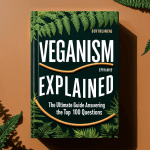As more individuals embrace plant-based diets, understanding how to maintain a balanced and nutritious vegan lifestyle becomes essential. The Vegan Food Guide Pyramid serves as a visual representation of the types of foods that should form the foundation of a healthy vegan diet. This guide not only emphasizes the importance of various food groups but also provides practical recommendations for daily consumption. Let’s explore the structure of the Vegan Food Pyramid, its components, and how it can help you achieve optimal nutrition.
The Vegan Food Pyramid: Origins, Purpose, and Scientific Backing
As the popularity of plant-based diets continues to grow, the Vegan Food Pyramid has emerged as a vital tool for guiding individuals toward balanced nutrition. This pyramid not only outlines the types of foods that should form the foundation of a vegan diet but also serves as a resource for understanding how to meet nutritional needs effectively. In this article, we will explore the origins of the Vegan Food Pyramid, its purpose, and the scientific research supporting its recommendations.
Origins of the Vegan Food Pyramid
The Vegan Food Pyramid was developed from earlier dietary guidelines, including the traditional food pyramid that promotes balanced eating. One significant version is the Giessen Vegan Food Pyramid, created by researchers at the Research Institute for Plant-Based Nutrition in Germany. This pyramid was designed to address the specific nutritional needs of vegans while ensuring that they meet dietary recommendations.The Giessen Vegan Food Pyramid was developed under the guidance of Dr. Markus Keller, a nutritionist specializing in vegetarian and vegan diets. The researchers conducted a thorough analysis based on a 14-day vegan meal plan, optimizing it to ensure adequate nutrient intake. They focused on critical nutrients often lacking in vegan diets, such as protein, iodine, iron, omega-3 fatty acids, and zinc. This scientific approach resulted in a pyramid that provides clear guidelines for food consumption while emphasizing nutrient density.
Purpose of the Vegan Food Pyramid

The primary purpose of the Vegan Food Pyramid is to promote a balanced and healthful vegan diet. It serves as a visual representation of food groups arranged in order of recommended intake:
- Grains: At the base of the pyramid, whole grains form the foundation, providing essential carbohydrates and fiber.
- Vegetables: A wide variety of vegetables is encouraged for their vitamins, minerals, and antioxidants.
- Fruits: Fruits are included for their natural sugars and additional nutrients.
- Legumes: Beans, lentils, and peas are vital sources of protein and should be consumed regularly.
- Nuts and Seeds: These provide healthy fats and additional protein but should be eaten in moderation due to their caloric density.
By following this structure, individuals can ensure they consume a diverse range of nutrients necessary for optimal health.
Scientific Research Supporting the Vegan Food Pyramid
Numerous studies have examined the health benefits associated with plant-based diets, reinforcing the principles behind the Vegan Food Pyramid. Research indicates that individuals following vegan diets tend to have lower risks of chronic diseases such as heart disease, type 2 diabetes, and certain cancers.
- Nutritional Adequacy: Studies show that vegans often meet or exceed dietary recommendations for essential nutrients like fiber, vitamins C and E, and various phytochemicals compared to omnivores. For instance, research published in Nutrients highlights that vegans typically have higher intakes of beta-carotene and folate—nutrients abundant in plant foods.
- Chronic Disease Prevention: A review published in The American Journal of Clinical Nutrition found that plant-based diets are associated with lower blood pressure levels and improved cholesterol profiles. These findings suggest that following guidelines similar to those outlined in the Vegan Food Pyramid can contribute to better cardiovascular health.
- Weight Management: Research has also indicated that individuals on plant-based diets tend to have lower body mass indexes (BMIs) compared to those consuming omnivorous diets. This aligns with the pyramid’s emphasis on whole foods that are nutrient-dense yet lower in calories.
- Sustainability: The environmental impact of plant-based eating is another area supported by research. Studies show that reducing meat consumption can significantly lower greenhouse gas emissions associated with food production.
The Vegan Food Pyramid serves as an essential guide for anyone looking to adopt or maintain a balanced vegan diet. Developed through scientific research and expert guidance, it emphasizes nutritional adequacy while promoting ethical eating practices. By following this pyramid, individuals can enjoy a diverse array of foods that support their health while contributing positively to animal welfare and environmental sustainability. As more people embrace plant-based lifestyles, resources like the Vegan Food Pyramid will play a crucial role in helping them navigate their dietary choices effectively.
Understanding the Vegan Food Pyramid
The Vegan Food Pyramid is structured similarly to traditional food pyramids but focuses exclusively on plant-based foods. It typically consists of five main food groups organized in a hierarchy that reflects their recommended proportions in a balanced diet:
- Grains: At the base of the pyramid, grains form the foundation of a vegan diet. Whole grains such as brown rice, quinoa, oats, and whole grain bread provide essential carbohydrates, fiber, and various vitamins and minerals. It is recommended to consume several servings of whole grains daily to ensure adequate energy levels and nutrient intake.
- Vegetables: Above grains, vegetables occupy a prominent position in the pyramid. They are rich in vitamins, minerals, and antioxidants while being low in calories. A diverse intake of vegetables—preferably five servings per day—ensures that you receive a wide range of nutrients essential for overall health.
- Fruits: Fruits are also crucial in a vegan diet and should be consumed regularly. They provide natural sugars, fiber, vitamins, and minerals. Aim for at least two to three servings of fruit each day to benefit from their nutritional properties.
- Legumes: This group includes beans, lentils, chickpeas, and peas, which are excellent sources of protein, fiber, iron, and other essential nutrients. Incorporating legumes into your meals helps meet protein needs while providing important micronutrients.
- Nuts and Seeds: At the top of the pyramid are nuts and seeds, which provide healthy fats, protein, and various vitamins and minerals. While they are nutrient-dense and beneficial for heart health, they should be consumed in moderation due to their high caloric content.
- Healthy Fats: Although not always depicted as a separate tier in every pyramid model, healthy fats from sources like olive oil, avocado, and nut butters play an important role in a balanced vegan diet. These fats support brain health and aid in the absorption of fat-soluble vitamins.
Challenges in Following the Vegan Food Pyramid

While the Vegan Food Pyramid provides a clear framework for healthy eating, there are challenges that individuals may face when adopting this dietary approach:
- Nutritional Deficiencies: Key nutrients such as vitamin B12, iron, calcium, omega-3 fatty acids, and zinc can be harder to obtain from a vegan diet alone. Individuals need to be mindful of these nutrients and consider fortified foods or supplements where necessary.
- Meal Planning: Transitioning to a vegan diet requires thoughtful meal planning to ensure all nutritional needs are met while avoiding processed foods high in sugar or unhealthy fats.
- Social Situations: Dining out or attending social gatherings can pose challenges when options are limited or not clearly labeled as vegan-friendly.
- Variety and Taste: Some may struggle with finding diverse recipes that keep meals interesting while adhering to the guidelines of the Vegan Food Pyramid.
How to Overcome These Challenges
- Educate Yourself: Familiarize yourself with vegan nutrition by consulting resources like vegan cookbooks or nutrition guides that emphasize balanced meals based on the food pyramid.
- Plan Meals Ahead: Use meal planning tools or apps that help you organize your weekly meals according to the food pyramid guidelines. This ensures you include all necessary food groups.
- Experiment with Recipes: Explore various cuisines that emphasize plant-based ingredients—such as Mediterranean or Asian dishes—to keep your meals exciting and flavorful.
- Communicate Your Needs: When dining out or attending gatherings, don’t hesitate to inform hosts about your dietary preferences or suggest restaurants with vegan options.
- Utilize Cookbooks: A well-crafted vegan cookbook can be an invaluable tool in your kitchen. Look for cookbooks that offer recipes aligned with the Vegan Food Pyramid principles—focusing on whole foods while providing practical tips for meal prep and ingredient substitutions.
The Vegan Food Guide Pyramid serves as an excellent resource for anyone looking to adopt or maintain a balanced vegan diet. By understanding its structure and recommendations—and addressing potential challenges—you can ensure that your plant-based lifestyle is both nutritious and enjoyable. With careful planning and the right resources at hand, embracing a diet centered around plants can lead to improved health outcomes while supporting ethical eating practices and environmental sustainability!
The Advantages of Following the Vegan Food Pyramid
As more individuals adopt plant-based diets, the Vegan Food Pyramid serves as a valuable guide for ensuring balanced nutrition. This pyramid emphasizes the importance of various food groups, helping individuals make informed dietary choices. Here, we explore the advantages of following the Vegan Food Pyramid and how it can contribute to overall health and well-being.
1. Nutritional Balance
One of the primary advantages of adhering to the Vegan Food Pyramid is its emphasis on nutritional balance. The pyramid encourages a diverse intake of food groups, including whole grains, fruits, vegetables, legumes, nuts, and seeds. By following this structure, individuals can ensure they are receiving a wide range of essential nutrients necessary for optimal health. This balanced approach helps prevent nutritional deficiencies that may arise from a poorly planned vegan diet.
2. Encouragement of Whole Foods
The Vegan Food Pyramid promotes whole foods over processed options. By focusing on natural ingredients such as fruits, vegetables, and whole grains, individuals are more likely to consume fewer additives and preservatives. This shift toward whole foods can lead to improved digestion, increased energy levels, and better overall health.
3. Rich in Fiber

Plant-based diets are inherently high in dietary fiber, which is crucial for digestive health. The Vegan Food Pyramid encourages the consumption of fiber-rich foods like fruits, vegetables, legumes, and whole grains. Increased fiber intake can help regulate bowel movements, lower cholesterol levels, and promote a feeling of fullness—making it easier to maintain a healthy weight.
4. Lower Risk of Chronic Diseases
Numerous studies have shown that following a plant-based diet can reduce the risk of chronic diseases such as heart disease, type 2 diabetes, and certain cancers. The Vegan Food Pyramid supports this by emphasizing foods that are low in saturated fats and high in antioxidants. By prioritizing these nutrient-dense foods, individuals can significantly improve their long-term health outcomes.
5. Weight Management
The structure of the Vegan Food Pyramid naturally supports weight management. Plant-based foods tend to be lower in calories while being high in volume due to their water and fiber content. This allows individuals to enjoy satisfying portions without excessive calorie intake. Following the pyramid’s guidelines can help those looking to lose or maintain weight achieve their goals more effectively.
6. Ethical Eating
For many individuals, adopting a vegan diet is rooted in ethical concerns regarding animal welfare and environmental sustainability. The Vegan Food Pyramid aligns with these values by promoting plant-based eating as a compassionate choice that minimizes harm to animals and reduces environmental impact. By following this guide, individuals can feel confident that their dietary choices reflect their ethical beliefs.
7. Variety and Culinary Exploration
The Vegan Food Pyramid encourages variety in food choices, which can lead to culinary exploration and creativity in the kitchen. With an emphasis on diverse food groups—such as legumes, grains, nuts, and vegetables—individuals are inspired to try new recipes and flavors. This not only keeps meals exciting but also ensures a broader spectrum of nutrients is consumed.
8. Community Support
Following the Vegan Food Pyramid can connect individuals with like-minded communities focused on plant-based living. Many resources are available—such as cookbooks, online forums, and local groups—that provide support and inspiration for those navigating a vegan lifestyle. Engaging with others who share similar dietary goals can enhance motivation and commitment.
9. Improved Mood and Energy Levels
Research suggests that adopting a plant-based diet can lead to improved mood and increased energy levels. By eliminating animal products that may contain toxins or hormones affecting mental health negatively, individuals often report feeling lighter and more energetic when consuming a diet rich in plants.
10. Practical Guidance for Transitioning
For those new to veganism or considering transitioning from an omnivorous diet, the Vegan Food Pyramid offers practical guidance on how to make this shift smoothly. It provides clear recommendations on portion sizes and food groups to prioritize, making it easier for individuals to plan meals that align with their nutritional needs.
Following the Vegan Food Pyramid presents numerous advantages for those seeking a balanced and nutritious plant-based diet. From promoting nutritional balance and encouraging whole foods to reducing the risk of chronic diseases and supporting ethical eating practices, this guide serves as an essential tool for anyone looking to embrace a vegan lifestyle. By incorporating the principles outlined in the pyramid into daily eating habits, individuals can enjoy improved health outcomes while contributing positively to animal welfare and environmental sustainability. Whether you’re just starting your plant-based journey or have been eating this way for years, the Vegan Food Pyramid can help you navigate your path toward optimal health!












